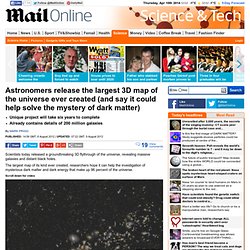

Universe. There are many competing theories about the ultimate fate of the universe.
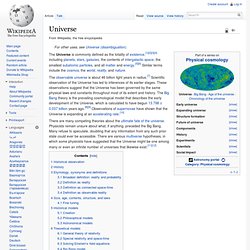
Physicists remain unsure about what, if anything, preceded the Big Bang. Many refuse to speculate, doubting that any information from any such prior state could ever be accessible. There are various multiverse hypotheses, in which some physicists have suggested that the Universe might be one among many or even an infinite number of universes that likewise exist.[11][12] Historical observation XDF size compared to the size of the Moon – several thousand galaxies, each consisting of billions of stars, are in this small view.
XDF (2012) view – each light speck is a galaxy – some of these are as old as 13.2 billion years[13] – the visible Universe is estimated to contain 200 billion galaxies. XDF image shows fully mature galaxies in the foreground plane – nearly mature galaxies from 5 to 9 billion years ago – protogalaxies, blazing with young stars, beyond 9 billion years. History Etymology, synonyms and definitions.
COSMOLOGY. Weird Science. Space Vine captures a never-setting sun from on board the ISS. Rogue 'orphan' planets develop without a sun thanks to tiny dust clouds. Astronomers used several telescopes to observe the Rosette Nebula, a huge cloud of gas and dust 4,600 light years from EarthThey found the nebula is home to more than 100 of the unusual planet-forming clouds, known as 'globulettes' By Sarah Griffiths Published: 17:04 GMT, 21 August 2013 | Updated: 15:03 GMT, 10 October 2013 Scientists think they have solved the mystery of why some rogue planets exist in space without orbiting a star.
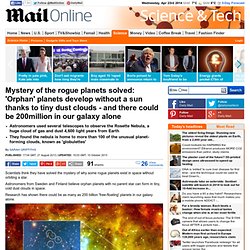
Astronomers from Sweden and Finland believe orphan planets with no parent star can form in tiny, cold dust clouds in space. Research has shown there could be as many as 200 billion 'free-floating' planets in our galaxy alone. The Rosette Nebula (pictured) is a huge cloud of gas and dust 4,600 light years from Earth which harbours hundreds of 'globulettes (inset). Until now it was assumed that such 'rogue planets' must have been ejected from their solar systems. But new observations point to the likelihood of some free-floating worlds forming on their own. Great balls of fire: The amazing video that shows a meteor EXPLODING. Michael K.

Chung was photographing the 2013 Perseids Meteor Shower last week from his garden in Victorville, CaliforniaThe U.S. photographer discovered he had captured what he thought was a meteor explosion and debris scattering when he processed his picturesAn astronomer believes Mr Chung recorded 'a persistent train after a Perseids fireball, being torn apart by upper atmosphere wind shear' By Sarah Griffiths Published: 11:32 GMT, 20 August 2013 | Updated: 14:48 GMT, 20 August 2013 The extraordinary moment a meteor exploded in the Earth's upper atmosphere has been accidentally captured by a U.S. photographer and designer.
Michael K. Rare night clouds and glowing aurora: Astronomer captures incredible footage of two phenomena in Scottish night sky. Maciej Winiarczyk, 41, captured the images in Caithness, ScotlandNoctilucent, or 'night-shining', clouds are normally too faint to be seenHalf way through the video the clouds are joined by a spectacular aurora By Ellie Zolfagharifard Published: 11:40 GMT, 20 August 2013 | Updated: 13:09 GMT, 20 August 2013 A stunning time-lapse video of a rare celestial show has been captured dancing across a night sky.

The recording gives a rare glimpse of rolling noctilucent clouds and dancing aurora glimmering across the horizon. The astronomer witnessed the famous Northern Lights and 'night clouds' earlier this month, over a single night above Caithness, Scotland. It is unusual to see either phenomena, and incredibly rare to see both simultaneously. Cassini: First pictures of Earth taken from NASA spacecraft orbiting Saturn.
Photos taken from Saturn by Nasa's Cassini spacecraft show Earth as a tiny pale blue dotThe images have been transmitted from 898 million miles away on the outer edge of our solar system By Michael Zennie Published: 03:44 GMT, 22 July 2013 | Updated: 00:41 GMT, 28 July 2013 Earth appears as an insignificant-looking pale blue dot below Saturn's majestic rings in a breathtaking new image from the Cassini spacecraft.
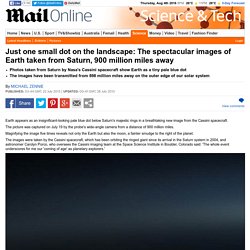
TheScaleoftheUniverse. Ten of the Most Interesting Structures of the Universe. Image Credit: EasyJet To quote the late Douglas Adams (the beloved author of “The Hitchhiker’s Guide to the Galaxy”): “Space is big.
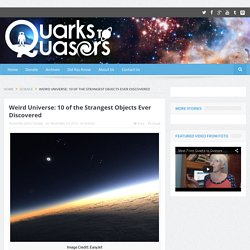
You just won’t believe how vastly, hugely, mind- bogglingly big it is. I mean, you may think it’s a long way down the road to the chemist’s, but that’s just peanuts to space.” Truer words have never been spoken. In fact, the universe is so big that it’s size and scope is nearly incomprehensible, even to the most knowledgeable and open minded individuals. 4 Purported Ways in Which the Universe Could End.
Artist’s illustration of the brightest galaxy in the universe, shining with light equivalent to more than 300 trillion sunlike stars.
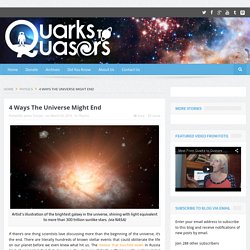
(via NASA) If there’s one thing scientists love discussing more than the beginning of the universe, it’s the end. There are literally hundreds of known stellar events that could obliterate the life on our planet before we even knew what hit us. The meteor that touched down in Russia kind of cemented that fact; however, the chances of Earth suffering a life-ending global catastrophe are actually rather slim.
But we know that it is coming. The end of everything else though, is a little bit more difficult to predict; however, that won’t stop scientists from speculating and theorizing. Peering into the Dark Ages of space: Hubble goes to extremes to present the deepest view of the universe ever seen by mankind. By Daily Mail Reporter Published: 21:12 GMT, 25 September 2012 | Updated: 11:57 GMT, 26 September 2012.
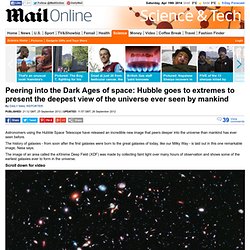
Photos: The Infrared Universe Seen by Spitzer Telescope. Most Complete Universe Simulation Visualized in 3D. Big Bang, Expanding & Accelerating Universe. The Universe: Season 3. Multiverse. Atlas of The Universe. The Detailed Universe: This will Blow Your Mind. The Skeptics' Guide To The Universe. Astronomers release the largest 3D map of the universe ever created. Unique project will take six years to completeAlready contains details of 200 million galaxies By Mark Prigg.
